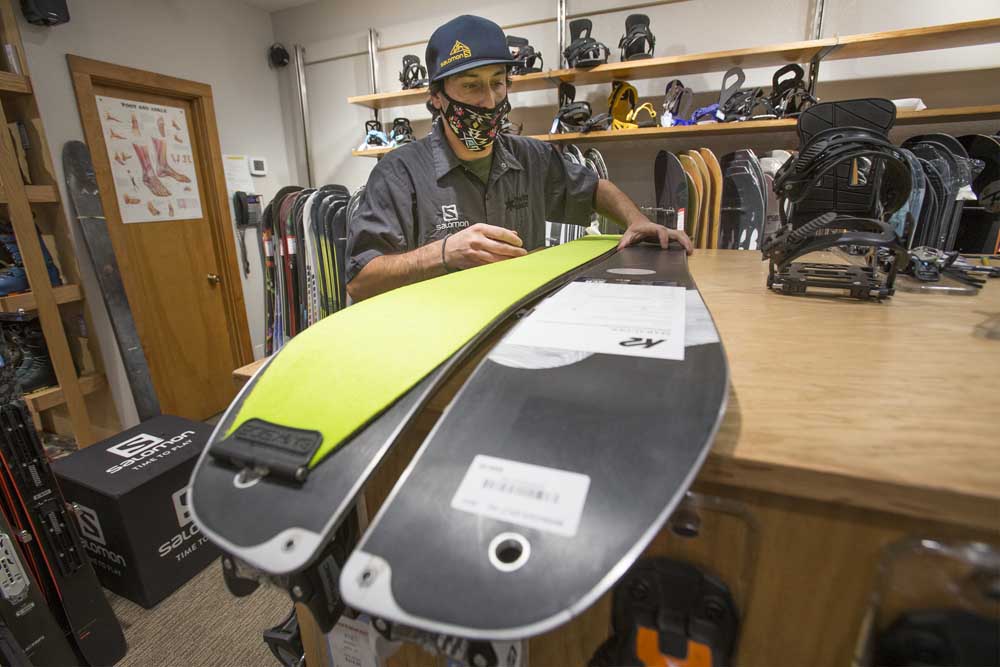Snowboards continue to evolve
Published 4:00 am Friday, September 18, 2020

- Steven Siegel demonstrates how to attach skins to a split board while working Wednesday at Powder House Ski & Snowboard in Bend.
Steven Siegel made the switch from skiing to snowboarding 17 years ago when he figured out that his love for skateboarding could be taken to the mountain during the winter months.
“My parents were diehard skiers, and they were like ‘are you sure?’ and I never went back,” said Siegel, who is a snowboard technician at Powder House Ski and Snowboard.
Working in ski shops for more than five years, Siegel said there have been subtle snowboarding gear changes. From boots being lighter and more comfortable, with seamless inlining to how companies like Burton are using 3D printers to build its binding straps for a more flush and secure fit with the boots.
But the boards, he said, are where the differences are more prominent over the past couple of years. One of the newer trends is Volume Shift snowboards. Meaning that the board’s surface area has shifted from length to width so that the snowboards are shorter and wider than previous versions.
What the Volume Shift boards do that is different, Siegel says, is allow for swifter and more sharp carves in the snow than the longer, traditional boards. The larger surface prevents snowboards from sinking too deep in the snow while still carving down the mountain.
“They do ride drastically different,” Siegel said. “Before you had to ride a really long board to get that float on the snow. Now with the profile that they are using and making it fatter, now you don’t have to have to make as wide of turns. They are quicker to turn, you still get that float. Riding one for the first time it feels like you are on a skateboard. But you get used to it really quick.”
Mt. Bachelor announced this week that it is planning on opening its ski lifts in November. But if something arises that forces the ski resort to close its lifts, like it had to at the start of the spring skiing season, then splitboards provide a solution should that happen.
A splitboard looks like a typical snowboard but can split into two halves to makes skis for traveling uphill without a ski lift or doing backcountry riding. They can do so by adding skins to the bottom of the skis to help gain traction while skiing up a hill, then either ski or reassemble the snowboard and ride down the mountain.
“It could be really popular this year because people could be nervous if Bachelor is going to stay open all winter,” Siegel said. “We are anticipating that we might get a good amount of backcountry stuff going on this year with people hiking to avoid the ski areas.”
But split boards do not ride the same way as the standard snowboard. They are designed for backcountry riding rather than going off jumps in terrain parks.
“It generally feels like a snowboard, obviously a regular snowboard is going to ride a little bit better than a splitboard,” said Bobby Chapman, the shop manager at Tactics. “Generally when you are riding a split board you are riding it in deep snow and in the backcountry. You wouldn’t have someone who rides in terrain parks buying splitboards.”
The snowboards now are becoming “softer,” meaning that they are more flexible and less stiff. So now, snowboards are becoming more unisex, where before there was a distinct difference between men’s and women’s boards.
“The only difference between men’s and women’s boards is that they put less material in women’s boards to make them more flexible,” Siegel said. “There are more taller ladies snowboarding now and companies are now just starting to come around to making boards tall enough boards, but we usually have to special order the. I think the companies are trying to get away from that and make them so that they can cross over and still be able to ride.”






